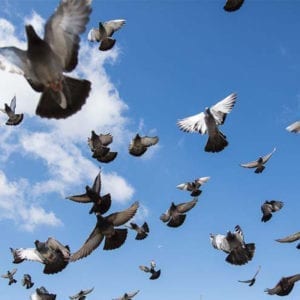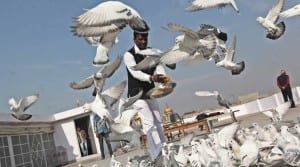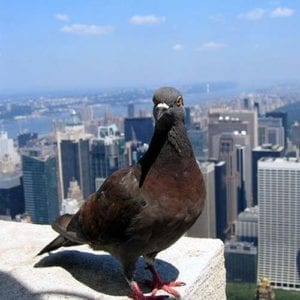
by johnnymarin | Jan 21, 2019 | Pigeon Patrol's Services
 The pigeons roosting on the roof of the Grill on the Gull on Bobcaygeon Road in Minden have become a familiar sight for many walking or driving down the main street of the village.
The pigeons roosting on the roof of the Grill on the Gull on Bobcaygeon Road in Minden have become a familiar sight for many walking or driving down the main street of the village.
Pigeons have been reported in the Haliburton and Minden area since at least 2010, when 40 were spotted in Minden, then reported to and recorded on the eBird website in February that year, according to Mark Peck, manager of the Schad Gallery of Biodiversity at the Royal Ontario Museum.
“They are pretty tough birds and regularly winter as far north as Cochrane and Timmins in Ontario,” said Peck. “My guess is [the pigeons being seen in Minden and Haliburton] have a reliable food source or someone is feeding them. They are not really choosy with their food: bread, bird seed and anything else grain-related works.”
Rock pigeon, the kind of bird hanging out in downtown Minden and spotted around the streets of Haliburton, is the common name for the domestic pigeon which were introduced from Europe according to Peck, though some readers might remember when they were called rock doves. In the winter, they are often found in groups of 10 to several hundred birds. In the summer, they nest on or near manmade structures, although they were originally cliffnesters, Peck told the Times.
“They are pretty much restricted to urban and rural areas and are rarely found away from human settlement,” he said. “They tend to favour certain perches, train trestles, bridges, certain hydro lines and certain buildings, especially farms. They will often stay in the area for years providing there is a good enough food source.”
Jean Neville remembers a time when it wasn’t so common to see feral pigeons in the area.
“There were never wild pigeons around when I was growing up here,” she said. “In Toronto, there were always wild pigeons. My dad always said they were lost out of racers, because they’re mainly homers if you look at them.”
Neville’s dad, Alfred Bertram Warder, was a pigeon fancier, and was so keen on the bird, he wrote the breed standard (a set of guidelines that defines an animal breed’s perfect observable qualities) for the English Trumpeter pigeon.
“That was his favourite kind of pigeon, and he was so into pigeon fancying that he could judge pigeons against their standard,” she said. “I think he was asked to [write it], because he knew that breed very well.”
The English Trumpeter is a type of fancy pigeon.
“They have really big muffs on their feet, of feathers,” she said. “They have a little crest on top of their nose, and a crest on their heads. They called them English Trumpeters because the way they coo made people think of a trumpet.”
When she was a child in the 1950s and 1960s, Neville remembers the crates her dad would use to ship the birds to Toronto to participate in the Royal Winter Fair and Canadian National Exhibition poultry showings – they were stamped with his name, A.B. Warder & Sons, which she said she used to complain about as “daughter” wasn’t mentioned. The train would pick the crates up in Haliburton, or would stop in Lochlin for them, and Neville and her dad and brother would join them in Toronto, where she and her brother would play at the midway while her dad showed the birds.
“It’s funny because before the CNE or the Royal Fair, some of the ones that had specific perfect markings on them, we’d have to pluck out certain feathers that weren’t supposed to be – if they had a dark bit on them where the white was supposed to be,” she laughed, remembering. “There with tweezers, my brother and Dad and I pulling them, before we shipped them.”
Neville said the pigeons were referred to as “poor people’s race horses,” given their affordability compared to a larger animal.
“It was quite a hobby back in those days, and they paid for themselves, [Dad] always said they paid for themselves, because he sold them, and also there were proceeds from the fair and the CNE,” said Neville. “He had quite a few birds.”
Because Neville grew up with fancy pigeons in her life, she ended up learning quite a bit about the birds. Pigeons mate for life, and they usually only lay two eggs at a time, with a gestation period of about 17 days.
“I always thought female pigeons were very smart because they sit on the nest at night,” she said. “The cockbird sits on the eggs in the daytime so the hen can fly around, do whatever she wants.”
Pigeons regurgitate milk, using stones to grind the grain in the gizzard, which both the male and females use to feed their young. Neville lists some birds of note: the runt, which is quite a large pigeon, almost the size of a chicken; the king, which are quite large as well; the Lahore, characterized by a white front and a black back; the Modina, which comes from Italy and some birds that provided entertainment as part of their domestic duties.
“There’s also a kind they used to have in the gentry, the kings and queens, they were called parlour tumblers,” she said. “They’re quite a boring looking bird, but they can fly up until they’re about a year old, and then they lose the ability to fly. You put them on the floor and they tumble in a straight line across the floor. People used to use them for entertainment, in their parlour. They judged them according to how straight they could tumble on the floor. Then there’s rollers, that people get confused with parlour tumblers. Rollers can fly, but they fly really, really high and then they fly long and then they roll in the air.”
A few wild pigeons do visit Neville’s family’s farm on County Road 1, which she suspects are possibly the ancestors of birds released into the wild from local pigeon handlers. She still keeps a few English Trumpeters today.
“I just have them because we always had pigeons and I enjoyed my English Trumpeters because my dad always had them,” said Neville, quite the pigeon fancier herself.
Matt Wesley, a local farmer, has roots that go back about 150 years in Carnarvon, where his grandmother was born at home on a farm.
Around 1900 to 1940, Wesley said pigeons were one of the usual barnyard fowl kept in the county.
“On our farm, and I assume on most farms, pigeons being fairly upwardly mobile were mostly left to their own devices,” he said. “They would flap around the barnyard and greater farm area to forage, as well as clean up any spilt grain in the granary or around outside feeding areas with the other barnyard fowl. They also had the ability to forage a greater area than any other creature kept, as they can obviously fly further afield than a chicken, duck or turkey. During the summer months, they were mostly left to their own devices, and did very well indeed. In the winter, they were fed whatever was fed to other poultry, with most or all grain being grown on the farm, depending on the year.”
Wesley’s grandmother, a Cowan, grew up during the Depression.
“At the time, though no one had any money, which I don’t think would be a surprise, but I know that on our farm, no one was ever hungry,” he said. “Pigeons played no small role in this as pigeon can, and regularly do have as many as four or five broods a year. The weather would really have been the only limiting factor to the prolificness of these birds in the area.” Pigeons were easy to keep and matured quickly, offering meat that could be served in a variety of ways. “The wings and drumsticks left something to be desired, but the breast of a squab has a good chunk of meat on it,” said Wesley. “Pigeon pie was a staple on our farm, as you could stretch it out with veggies and crust. I would warrant that the effort required to pluck out a whole bird is why I was never told any stories about pigeon soup or stew in an attempt to get more out of the animal, but I am sure that whatever meat was left was never wasted, going either to the cats or the dogs …”
Wesley said housing pigeons was simple, with wooden crates nailed to the walls of the gables of the barn.
“When it was time to get a squab or two for dinner, one of my uncles would be sent out after dark when the pigeons were roosting,” he said. “Get a ladder, or climb the ladders so often built into the hay mow of old barns, stick your hand in and grab a bird. Tuck it in your shirt, grab another. Pretty easy.”
Being easy prey is in large part what caused the passenger pigeon to go extinct, with the last one of its kind, Martha, dying in the Cincinnati Zoo in 1914. Haliburton’s museum is home to a rare specimen of a stuffed passenger pigeon.
“The one we have at the museum came to us in 1985 as part of a collection of five cases of birds donated by Gordon Fraser of Stoney Lake,” said Kate Butler of the Haliburton Highlands Museum, who said she believed the birds had been on display at a local hunt camp. “The really interesting thing about the collection is that when it was donated to us, it was already a piece with a long history. The birds were preserved as part of the work of Peterborough taxidermist Edwin Elcome from the 1890s. He used the birds as examples of his work when talking to potential clients.”
The story of the passenger pigeon itself is mind boggling, according to Butler.
“It was once one of the most populous birds in North America and travelled in flocks so huge it was said that the sky would go dark when they flew overheard – perhaps hyperbole, perhaps not! They were discovered to be a great food source though and likely fairly docile, so they began to be hunted in huge numbers until there were only a scant number left and those birds seemed to not be inclined to breed in captivity.”
As for the pigeons spotted in the wild locally, Peck said they might just be Haliburton County residents now.
“They could belong to someone if you have a pigeon fancier in the area, but my guess is these are wild birds that have decided to call Minden and Haliburton home,” said Peck. “Good choice, too. We just bought a cottage near Harcourt and love the area.”
About Pigeon Patrol:
Pigeon Patrol Products & Services is the leading manufacturer and distributor of bird deterrent (control) products in Canada. Pigeon Patrol products have solved pest bird problems in industrial, commercial, and residential settings since 2000, by using safe and humane bird deterrents with only bird and animal friendly solutions. At Pigeon Patrol, we manufacture and offer a variety of bird deterrents, ranging from Ultra-flex Bird Spikes with UV protection, Bird Netting, 4-S Gel and the best Ultrasonic and audible sound devices on the market today.
Voted Best Canadian wholesaler for Bird Deterrent products four years in a row.
Contact Info: 1- 877– 4– NO-BIRD (www.pigeonpatrol.ca)

by johnnymarin | Jan 20, 2019 | Pigeon Patrol's Services

Gangtok,Jan 17 (UNI) Minister Tourism & Civil Aviation,Ugen Gyatso Bhutia,declared Sikkim Red Panda Winter Carnival,open,by releasing birds of peace,white pigeons ceremoniously,joined by Secretary Tourism TT Bhutia. The Carnival, kick started at Mahatma Gandhi Marg just the heart of town had good response on the first day, today. ‘The neighbouring Countries and State are also participating,like Nepal,Bhutan and Gorkha Territorial Administration (from West Bengal). British Council from Kolkata will also be there,’ said the Minister Ugen Gyatso. The Tourism Department,has put up a tastefully sculptured and hand painted 5’ high Red Panda.The annual footfall is 40 Lakhs presently but the State target is of 50 Lakh tourists annually. Nepal and Bhutan have put up their stalls along with others.Nepalese have put up Dhaka stoles and clothing material caps for sale and Bhutanese are selling hand made bags and Chinese brocade costumes.The visitors were most attracted towards exhibition put up by Eco-stream,live demonstration by Carpet weavers from Handloom & Handicrafts and of course ethnic fast foods. The Artists from Nepal,Bhutan,Kalimpong and Wings of Sikkim with other local artists will be presenting cultural show on 18th .Earlier the 3 day Carnival started with Fitness camp , Yoga and Meditation.
About Pigeon Patrol:
Pigeon Patrol Products & Services is the leading manufacturer and distributor of bird deterrent (control) products in Canada. Pigeon Patrol products have solved pest bird problems in industrial, commercial, and residential settings since 2000, by using safe and humane bird deterrents with only bird and animal friendly solutions. At Pigeon Patrol, we manufacture and offer a variety of bird deterrents, ranging from Ultra-flex Bird Spikes with UV protection, Bird Netting, 4-S Gel and the best Ultrasonic and audible sound devices on the market today.
Voted Best Canadian wholesaler for Bird Deterrent products four years in a row.
Contact Info: 1- 877– 4– NO-BIRD (www.pigeonpatrol.ca)

by johnnymarin | Jan 18, 2019 | Pigeons in the News
 A heartbroken owner’s prized racing pigeons were burned alive when the cage they were kept in went up in flames.
A heartbroken owner’s prized racing pigeons were burned alive when the cage they were kept in went up in flames.
The turn of the new year brought devastation for Liam Hope when his beloved birds were incinerated in a blaze at his loft on Benton Road, West Allotment.
The 28-year-old car valet from North Shields was immensely fond of his pigeons – keeping some as pets – and described them as his “whole life”.
He told ChronicleLive: “I’m absolutely gutted, these pigeons were my whole life and I would visit them most days after work.
“I’ve been around them since I was born, my dad, granddad and great-granddad all raced pigeons too.
“I also got really attached to them and kept one retired bird, George, as a pet.”
The fire broke out in the early hours of New Year’s Day and neighbours in West Allotment alerted Liam to the blaze.
But by the time emergency services arrived it was too late and the 110 pigeons inside the cage were dead.
Liam raced the birds with his partners 81-year-old Brian Morris, who has owned the same loft for 50 years, and 65-year-old Colin Spillard.
The trio recently spent £2,500 on some new birds, which can cost up to £500 each.
“It’s going to cost a fortune to replace”, Liam said.
“The cage’s shell alone is worth around £4,000 and then there’s the cost of the birds.”
Despite the grief and weighty financial damage, Liam is confident that his pigeon racing career is not over and said that he will rebuild his successful team from scratch.
He has launched a GoFundMe campaign to help pay for the costs of building a new loft which has already gathered £585 in donations.
Liam’s specialist racing birds won five events last year and were kept on a protein-heavy diet but loaded with carbohydrates before they set off on the 800-mile round trip to France and back for competitions.
After extinguishing the blaze, the fire department’s investigation found there had been “no malicious ignition” and the flames must have started internally.
But Liam contests this and claims to have CCTV footage, that has not yet been seen by police, which shows a man torching the loft.
He said: “The camera’s not great but you can see a kid walk up to it and try to set it on fire.
“He doesn’t manage to at first, but then he comes back.”
A spokesperson for Northumbria Police said: “Police received a report from two officers of a fire at an allotment on Benton Road, West Allotment on New Year’s Day.
“The report was made at about 1.20am when officers reported a fire in a pigeon loft.
“The fire service attended to extinguish the fire and it is believed all the pigeons died in the blaze.
“The fire investigators found that there was no malicious ignition.”
They said that a trawl of nearby CCTV had been carried out in the aftermath of the fire but nothing suspicious was found.
About Pigeon Patrol:
Pigeon Patrol Products & Services is the leading manufacturer and distributor of bird deterrent (control) products in Canada. Pigeon Patrol products have solved pest bird problems in industrial, commercial, and residential settings since 2000, by using safe and humane bird deterrents with only bird and animal friendly solutions. At Pigeon Patrol, we manufacture and offer a variety of bird deterrents, ranging from Ultra-flex Bird Spikes with UV protection, Bird Netting, 4-S Gel and the best Ultrasonic and audible sound devices on the market today.
Voted Best Canadian wholesaler for Bird Deterrent products four years in a row.
Contact Info: 1- 877– 4– NO-BIRD (www.pigeonpatrol.ca)

by johnnymarin | Jan 17, 2019 | Pigeon Patrol's Services
 For more than two decades, Drew Lobenstein has taught communications at Moorpark College and is just shy of the impassable five stars on RateMyProfessor. However, he isn’t your average communications professor. Not only is Lobenstein admired by students for his devotion as a public speaking teacher, but very few know that he is an award-winning pigeon breeder. His pigeons can be found throughout the world, some even having reached establishments like the Beijing Zoo. In fact, Lobenstein has been awarded the “Lifetime Achievement Award” and been inducted into the “Hall of Fame” of the National Pigeon Association. Lobenstein sat down with reporter Ulises Koyoc to share how pigeons and public speaking have impacted his life.
For more than two decades, Drew Lobenstein has taught communications at Moorpark College and is just shy of the impassable five stars on RateMyProfessor. However, he isn’t your average communications professor. Not only is Lobenstein admired by students for his devotion as a public speaking teacher, but very few know that he is an award-winning pigeon breeder. His pigeons can be found throughout the world, some even having reached establishments like the Beijing Zoo. In fact, Lobenstein has been awarded the “Lifetime Achievement Award” and been inducted into the “Hall of Fame” of the National Pigeon Association. Lobenstein sat down with reporter Ulises Koyoc to share how pigeons and public speaking have impacted his life.
How did this passion for pigeon breeding come about?
“I was six when my father actually bought pigeons that we would use as food later, but he made me feed them every day so they got fatter and more tender. I don’t know why, but I got so attached to them that I begged him to not kill them after the first meal had been served. I was crying [and] my father said ‘Fine, you take care of them then.’ Maybe he did this to shut me up.”
Pigeon breeding is not a common hobby nowadays, why still do it?
“Because I’ve done it since I was a little boy so it’s been a part of me for more than half my life. Sure the hobby isn’t practiced much now in America, but other places like in Mexico or Asia still breed. I love doing it and meeting new people. I owe traveling the world to pigeons. These little birds gave me the opportunity to fly around the world for competitions. I can remember when on my street there [were] 13 guys breeding, now there’s only three of us in the entire San Fernando area.”
Do you think your family will carry on the tradition of breeding?
“My family has tried breeding before, but they didn’t enjoy it enough for them to continue. My daughters especially are more focused on other things than breeding pigeons. Pigeon breeding tends to be done by older guys who have a lot of time in their hands so when I see younger people at competitions it gives me a smile to know that the sport will continue.”
What is your favorite type of pigeon to breed?
“For me, my favorite is the Jacobin pigeon because they are so elegant in the physical sense and extremely smart. All pigeons tend to be intelligent but these Jacobins simply amaze me; their hoods and eyes are gorgeous. The downfall to Jacobins is that they take longer to breed than other types, but I think the reward is better.”
Do you think you’ve bred the perfect pigeon?
“I don’t think so, I’ve come close to breeding such a beautiful pigeon before, but it was not the best I’ve ever done. Maybe in my lifetime, I won’t be able to see such a pigeon, but that doesn’t mean I’m giving up. It takes time and patience to achieve what one wants, there’s still hope.
Between breeding pigeons and teaching, which is your greatest passion?
“This is a hard question, because teaching for me has been an outstanding journey. Helping students overcome their fear of public speaking is so rewarding because I’ve been in their shoes. Scared of going up and talking to a crowd was so terrifying to me. However, with some help, anything can be achieved. When it comes to breeding, I owe so much to those birds who have literally changed the course of my path. Both passions have helped me become a better person. I think it’s a tie for this question.”
Why become a public speaking teacher, if as a kid you were terrified of speaking?
“There was a point in my life as I got older where I did not want to keep quiet anymore. I just needed to let my voice be heard. Of course, I needed help, [and] by help I mean a lot of help. However, this made life so much easier being able to not only speak to a large group of my peers but even little conversations. Young people often find themselves searching for who they are and some don’t even know the importance of their voice. Some are natural talkers who go on forever and others aren’t. I wanted to help those who aren’t able to. Like I said before, I was in their shoes and that makes my job easier because I can relate to them.”
In what ways do you think your students change after taking your class?
“My job is to help them be better in speaking to crowds and I’ve noticed that some of my students come back to say how much of an impact my class was for them. Others on the last day of school say ‘thank you,’ and shake my hand. As a teacher, this is what we like to see. It makes us feel good. Over my course here at Moorpark College, people tend to be thankful of my job and that humbles me. I think I’ve done a pretty good job by all means.”
What do you consider your greatest achievement as a public speaking teacher?
“[My] greatest achievement is getting the opportunity to help students find their own voice in a noisy world.”
About Pigeon Patrol:
Pigeon Patrol Products & Services is the leading manufacturer and distributor of bird deterrent (control) products in Canada. Pigeon Patrol products have solved pest bird problems in industrial, commercial, and residential settings since 2000, by using safe and humane bird deterrents with only bird and animal friendly solutions. At Pigeon Patrol, we manufacture and offer a variety of bird deterrents, ranging from Ultra-flex Bird Spikes with UV protection, Bird Netting, 4-S Gel and the best Ultrasonic and audible sound devices on the market today.
Voted Best Canadian wholesaler for Bird Deterrent products four years in a row.
Contact Info: 1- 877– 4– NO-BIRD (www.pigeonpatrol.ca)

 The pigeons roosting on the roof of the Grill on the Gull on Bobcaygeon Road in Minden have become a familiar sight for many walking or driving down the main street of the village.
The pigeons roosting on the roof of the Grill on the Gull on Bobcaygeon Road in Minden have become a familiar sight for many walking or driving down the main street of the village.



